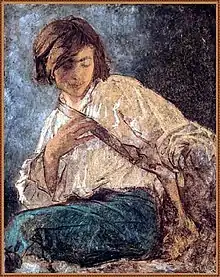Thomas Couture | |
|---|---|
 Thomas Couture, self-portrait | |
| Born | 21 December 1815 Senlis, Oise, France |
| Died | 30 March 1879 (aged 63) Villiers-le-Bel, Val-d'Oise, France |
| Resting place | Père Lachaise Cemetery, Paris, France |
| Education | École des Arts et Métiers |
| Known for | Painting, Author |
| Notable work | Romans in the Decadence of the Empire |


Thomas Couture (French pronunciation: [tɔma kutyʁ]; 21 December 1815 – 30 March 1879) was a French history painter and teacher. He taught such later luminaries of the art world as Édouard Manet, Henri Fantin-Latour, John La Farge,[1] Pierre Puvis de Chavannes, John Ward Dunsmore,[2] Karel Javůrek, William Morris Hunt,[3] and Joseph-Noël Sylvestre.
Life
Early life and education
Couture was born at Senlis, Oise, France. When he was 11 his family moved to Paris, where he would study at the industrial arts school (École des Arts et Métiers) and later at the École des Beaux-Arts.
Art and teaching career
He failed the prestigious Prix de Rome competition at the École six times, but he felt the problem was with the École, not himself. Couture finally did win the prize in 1837.
In 1840 he began exhibiting historical and genre pictures at the Paris Salon, earning several medals for his works, in particular for his masterpiece, Romans During the Decadence (1847). Shortly after this success, Couture opened an independent atelier meant to challenge the École des Beaux-Arts by turning out the best new history painters.
Couture's innovative technique gained much attention, and he received Government and Church commissions for murals during the late 1840s through the 1850s. He never completed the first two commissions, and the third met with mixed criticism. Upset by the unfavorable reception of his murals, in 1860 he left Paris, for a time returning to his hometown of Senlis, where he continued to teach young artists who came to him. In 1867 he thumbed his nose at the academic establishment by publishing a book on his own ideas and working methods called Méthode et entretiens d'atelier (Method and Workshop Interviews). It was also translated to Conversations on Art Methods in 1879, the year he died.
Asked by a publisher to write an autobiography, Couture responded: "Biography is the exaltation of personality—and personality is the scourge of our time."
Death
In 1879 he died at Villiers-le-Bel, Val-d'Oise, and was interred in Père Lachaise Cemetery, Paris.
Selected paintings
.jpg.webp)

 Anselm Feuerbach (1852)
Anselm Feuerbach (1852)![The Supper after the Masked Ball [1857]](../I/Thomas_Couture_-_The_Supper_after_the_Masked_Ball.jpg.webp) The Supper after the Masked Ball [1857]
The Supper after the Masked Ball [1857] The Duel After the Masked Ball (1857)
The Duel After the Masked Ball (1857) Daydreams (1859).
Daydreams (1859). A Lawyer Going to Court (1860s)
A Lawyer Going to Court (1860s).jpg.webp) The Thorny Path (1872)
The Thorny Path (1872)
Nazi-looted art in the Gurlitt collection
Couture’s Portrait of a Seated Woman, (c.1850-1855), discovered in the Gurlitt trove, was identified as having belonged to Georges Mandel from a small hole in the canvas. It was restituted to Mandel's heirs in 2019.[4][5]
References
- ↑ Wilkinson, Burke. The Life and Works of Augustus Saint-Gaudens, Dover Publications, Inc., New York. p. 79.
- ↑ "Portrait of Thomas Couture (1815-1879) on His Deathbed".
- ↑ "Artist Info".
- 1 2 "Nazi-Looted Thomas Couture Painting Returned to Heirs of French Jewish Leader Georges Mandel - Artsy News". 2020-09-24. Archived from the original on 24 September 2020. Retrieved 2022-02-20.
- 1 2 "Germany returns Nazi-looted work to French Jewish collector's heirs". lootedart.com. Retrieved 2022-02-20.
The portrait of a seated woman by 19th-century French painter Thomas Couture had been on display in a spectacular collection hoarded by Cornelius Gurlitt, the son of a Nazi-era art dealer. German Culture Minister Monika Gruetters presented the work to relatives of Mandel -- who was executed by French fascists near Paris in 1944 -- in a ceremony at the Martin Gropius Bau museum in Berlin.
Further reading
- Boime, Albert (1980). Thomas Couture and the Eclectic Vision. New Haven: Yale University Press. ISBN 978-0300021585.
- O'Neill, J., ed. (2000). "Index". Romanticism and The School of Nature: Nineteenth-century drawings and paintings from the Karen B. Cohen collection. New York: The Metropolitan Museum of Art.
External links
 Media related to Thomas Couture at Wikimedia Commons
Media related to Thomas Couture at Wikimedia Commons- Article on Thomas Couture